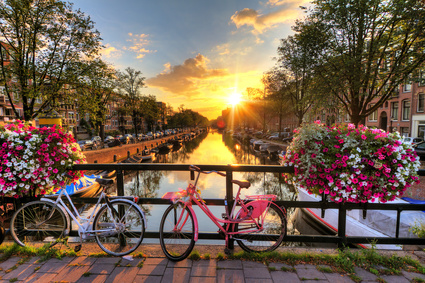 Amsterdam – the name inspires thoughts of impressionists and culture. Rembrandt and Vermeer in Rijksmuseum and the disturbing paintings of Van Gogh. The historic downtown, the culture and the canals are one reason to visit this great capital. Of course, for others it’s the spirit of ‘tolerance’ for things like soft drugs(pot smoking) and legal red light district which make it an interesting destination. As an observer at least.
Amsterdam – the name inspires thoughts of impressionists and culture. Rembrandt and Vermeer in Rijksmuseum and the disturbing paintings of Van Gogh. The historic downtown, the culture and the canals are one reason to visit this great capital. Of course, for others it’s the spirit of ‘tolerance’ for things like soft drugs(pot smoking) and legal red light district which make it an interesting destination. As an observer at least.
While Amsterdam is the capital of Netherlands, the government is based out of the Hague. Fewer paper pushers per square mile, as a rule of thumb is propotional to the joie de vive of a city, and distinguishes Amsterdam from many other European capitals. Amsterdam has been able to maintain it’s compactness and old world charm through a conscious effort rather than a stroke of fortune.
There is another side to Amsterdam as well its history as a mercantile power of the 17th century. The “Golden Age” of Amsterdam shows in its buildings, and the multicultural residents of Amsterdam are to some extent a result of the Dutch colonial history.
Most people are introduced to Amsterdam through the Schiphol airport. If you are unlucky enough to be stuck there due to a flight delay, you will notice that the gates don’t have bathrooms and have only eight seats for each planeload of passengers. While this Spartan introduction is unfortunate as well as uncomfortable(and not representative of the charm of Amsterdam), it gives an insight into the thought process of the Amsterdammers.
The Schiphol has a shopping area with the casino, and the airport authorities want you to spend most of your time there. Their hope is that you spend the time shopping and gambling, instead of taking up space in a comfortable lounge. Airlines love the arrangement too, given the cut rates offered by Schiphol as opposed to the more “full service” airports in Europe.
This unabashed capitalism goes hand in hand with the tolerant culture, making Amsterdam an enigma and a place to visit. For it’s beautiful tulips, as well as the memories of its famed Tulipmania, where the Dutch were trading tulip buds like .dotcom stocks!
The transportation system of Amsterdam is excellent, with the frequent tram service probably the best choice for traveling within the city. Renting a car therefore is usually a “very” bad idea, especially when compared to the ease of trams within this compact city. The less said the better about the parking situation in the city. A canal boat tour of the city, may also give you a look at the city from a different angle.
Anne Frank house, one of the most famous landmarks of Amsterdam, encompasses some of the painful history of this country. While the house is not remarkable, it is a monument to some terrible events. It’s worth a visit, especially if you have read the book.
Rijksmuseum, with its superb collection of paintings is reminiscent of the Central Station from the outside. That is, because they have the same architect! The main attractions are Rembrandt, Frans Hals and Steen, but there are more than 5000 paintings. The Van Gogh museum is right next door.
The Red Light District of Amsterdam is billed as a tourist attraction in most guide books. It’s actually quite safe to go there, if you keep your wits around you. The obvious things to remember is, to ignore the drug pushers or answer with a firm “NAY” and keep the camera in your hotel taking pictures here is inviting trouble. An occasional pick pocket aside, you get to see fat women in windows and giggly tourists trying to soak in the scene.
Amsterdam does not have much in the way of Pensions or Bed/Breakfast.
A native Californian, Jill went to college in Rhode Island. Pining for distant lands and new experiences, she traded her Ivory towers for a backpack and spent a year going around the world. While not working as a graphic designer for Sofizar, she travels the world, and writes about her experiences.







Leave a Reply